Joint Borrower Sole Proprietor Mortgage Stamp Duty
Joint Borrower sole proprietor mortgage stamp duty works slightly differently to normal stamp duty. It is usually lower.
What's in this article
How much is stamp duty?
Stamp duty is quite complicated and you should always consult a professional regarding how much you may have to pay. However, the following information should give you enough to approximate what you will need.
The following table shows what your stamp duty tax liability will be if you only own 1 residential property upon completion.
Property Value
Up to £250,000 | None |
From £250,001 – £925,000 | 5% of the value |
£925,001 – £1,500,000 | 10% of the value |
£1,500,001 + | 12% of the value |
The above table applies to most people, however, if you are a first time buyer the rules change slightly.
For a first time buyer the initial stamp duty free allowance is larger.
For First time buyers, Property value:
Up to £425,000 | None |
From £425,001 – £925,000 | 5% of the value |
£925,001 – £1,500,000 | 10% of the value |
£1,500,001 + | 12% of the value |
Why is Joint borrower sole proprietor mortgage stamp duty different?
With a Joint Borrower sole proprietor mortgage you will have a person on the mortgage that is not an owner of the property. This person can often be a homeowner themself. With a standard mortgage this would mean they were buying a second home, which is subject to an additional 3% payment on stamp duty.
However, with a Joint borrower sole proprietor mortgage the additional person on the mortgage is not usually an owner of the property. This therefore means that this additional 3% should not be charged.
The other factor is the first time buyer stamp duty allowance. Normally with the first time buyer allowance you would forfeit this if you had a non-first time buyer on the mortgage. However, with Joint borrower sole proprietor, if the non first time buyer isn’t owning the home, the buyer should retain their first time buyer allowance.
How much is Joint borrower sole proprietor mortgage stamp duty?
Joint borrower sole proprietor mortgage stamp duty is the same as any other purchase in terms of using the tables above to work out how much stamp duty is payable.
However, you only apply these to the person or people that will be owning the property. With a joint borrower sole proprietor mortgage the person who is the non-proprietor will not gain ownership of the property.
Joint borrower sole proprietor mortgage first time buyer stamp duty
As a first time buyer you receive an allowance on the first property you purchase. This allowance can be used for joint borrower sole proprietor mortgage stamp duty.
This therefore means you can usually buy a property up to £425,000 with the joint borrower sole proprietor scheme without paying stamp duty as a first time buyer.
Joint borrower sole proprietor mortgage to avoid stamp duty
The Joint borrower sole proprietor scheme was not designed to avoid stamp duty. However, you may find that people want to use it for this purpose.
Should you be trying to use the scheme to avoid stamp duty the lender may not see this as a good reason to do a mortgage like this rather than a traditional mortgage with all parties on the mortgage and deeds.
However, you should speak to a specialist mortgage broker as they will likely be able to advise on whether this is possible.

Who pays joint borrower sole proprietor mortgage stamp duty?
With a sole proprietor joint mortgage the stamp duty is usually only paid by the proprietor. The proprietor is the person that will own the property. As the non-proprietor is just going on the mortgage for affordability purposes and will not have ownership of the property they are usually not responsible for any stamp duty.
How is stamp duty calculated?
Stamp duty is calculated on the total value of the property. You then pay stamp duty based on the chart above.
However, you will pay stamp duty based on the value of the property in each threshold. For example:
If you are a First Time buyer, with a stamp duty free allowance of £425,000, and buy a house for £500,000, you will pay nothing on the first £425,000 and then 5% of the remainder.
So:
- 0% of £425,000 = £0
- 5% of £75,000 (The difference between £425,000 and £500,000) = £3,750
- So your total liability would be £3,750
However, if you were a non first time buyer, you would calculate it like this:
- 0% of £250,000 = £0
- 5% of the next £250,000 (The difference between £250,000 and £500,000) = £12,500
- So your total liability would be £12,500
Stamp duty for first time buyers
As first time buyers get this stamp duty free allowance, it is often preferential to buy a long term home that you will stay in for years. However, many first time buyers end up buying a flat or smaller home as their first property.
This is where a joint borrower sole proprietor mortgage can help, allowing you to buy a larger home that will last you longer and take advantage of more of your stamp duty free allowance.
Stamp duty on second homes
If you were to buy without the JBSP mortgage scheme you would end up paying second home stamp duty. This is an additional 3% on the total property price.
So if we go back to our earlier example, a property worth £500,000 as a non first time buyer and as a second home would look like this:
- 3% of £250,000 = £7,500
- 8% of the next £250,000 = £20,000
- So your total liability would be £27,500
Conclusion
As you can see, the joint borrower sole proprietor mortgage stamp duty costs are much lower than buying a second home with someone. This can be one of the main advantages of buying a property using the scheme.
Got a question about stamp duty we haven’t answered? Get in touch!
Why Albion Forest?
- Raising The standards of financial advice
- Making financial advice accessible to all
- Trusted & stress-free financial advice
- Friendly, personable advisors




